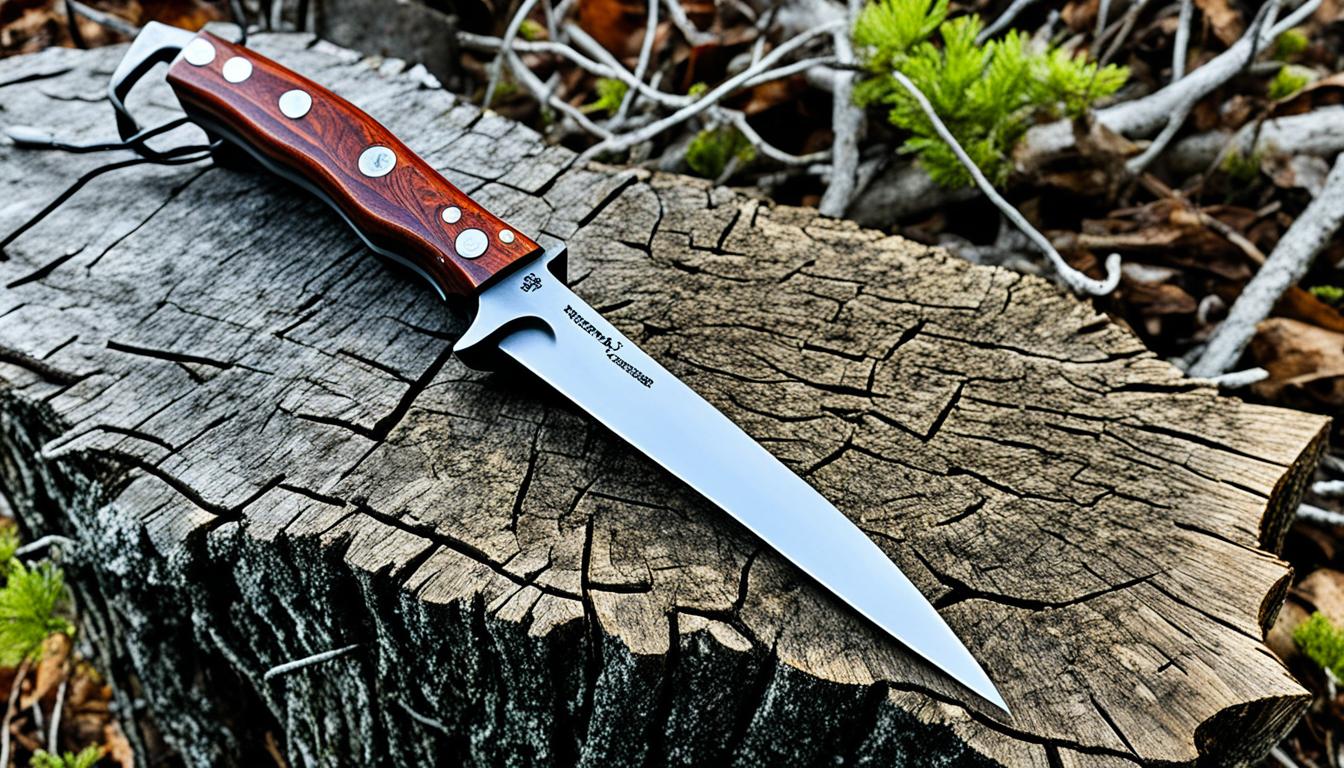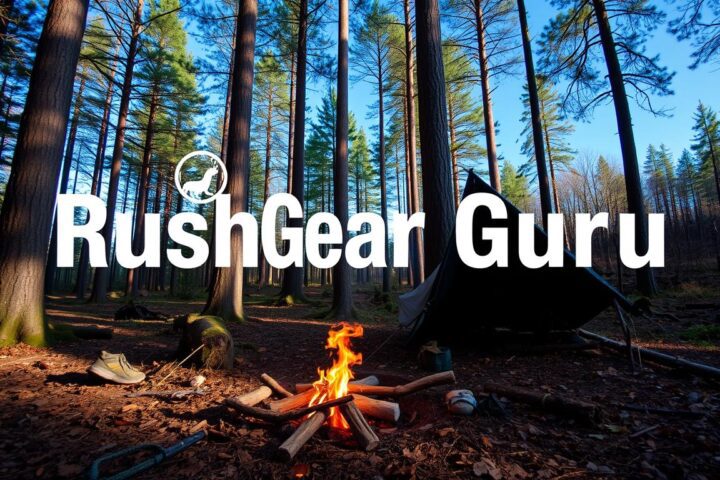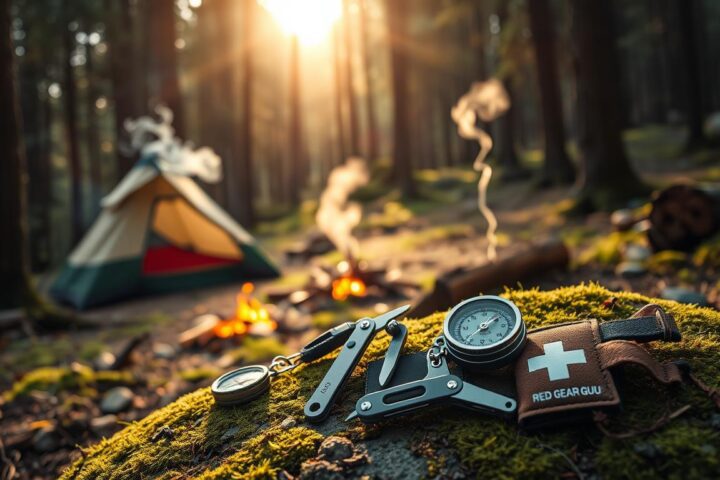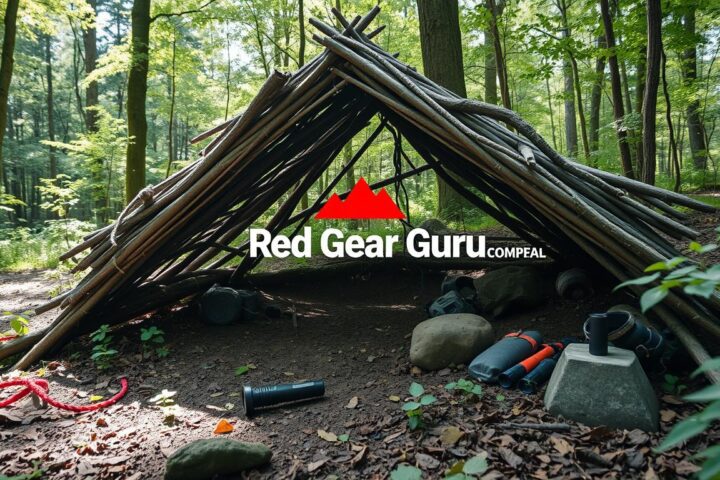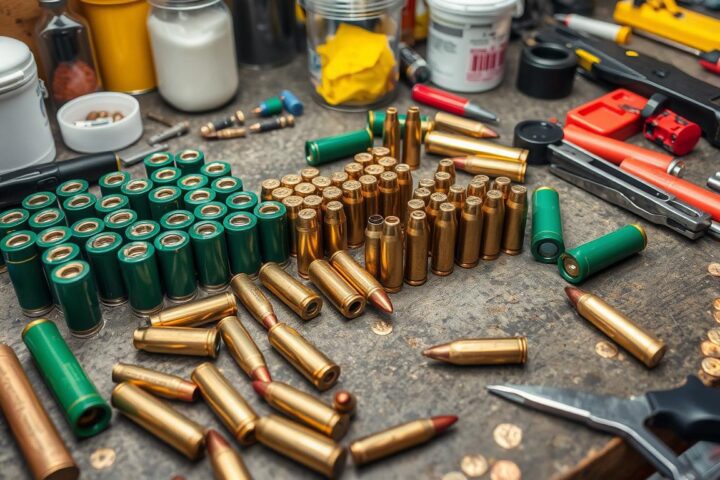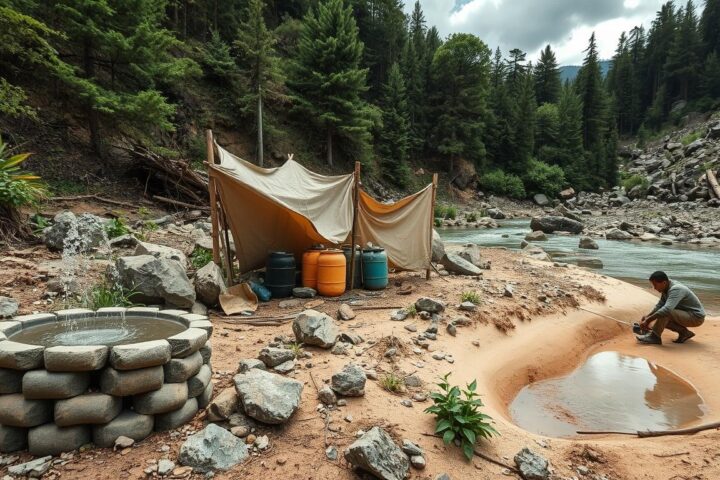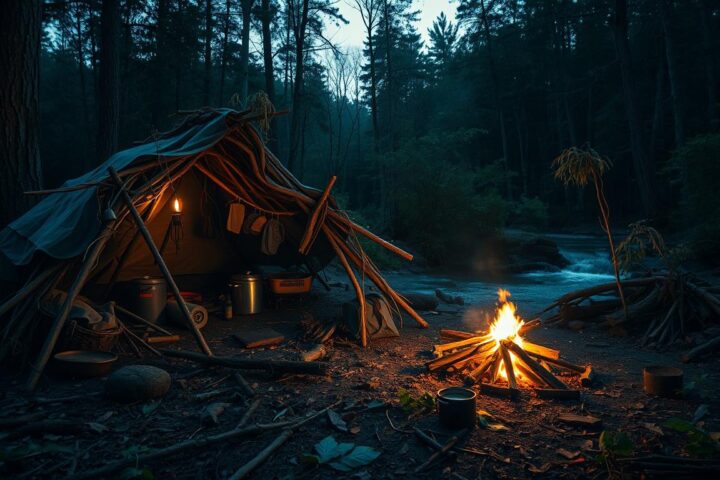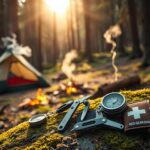Going on a camping trip is thrilling. But, having the right survival skills is key for a safe and fun adventure. We’ll look at the top survival skills every camper needs before they go.
These skills keep your camping trip safe and fun. They’re useful whether you’re new to camping or have been doing it for years. Skills like first aid, finding your way, starting a fire, building a shelter, and knowing about local wildlife are crucial.
Being prepared and respecting nature keeps you safe and helps protect the outdoors we love.
Mastering Fire Building Techniques
Fire is key for outdoor survival. It gives you warmth, lets you cook, and helps signal for help. As an experienced camper, I’ve found it vital to master different fire-making methods. This is crucial for improving your survival skills and bushcraft.
First, learn how to pick and prepare the right materials for starting a fire. This means choosing the best tinder, kindling, and firewood, even when it’s wet or hard. Practicing these methods will make sure you have the survival gear you need to keep a fire going.
- Gather Tinder: Find dry, fibrous stuff like dead leaves, twigs, paper, or dryer lint that catches sparks easily.
- Build a Kindling Nest: Put small, dry sticks in a criss-cross pattern for airflow and to support the tinder.
- Add Firewood: Start with thin twigs and add bigger pieces of wood, ending with thicker logs.
- Use a Fire-starting Tool: Try out different ways to start a fire, like matches, lighters, flint and steel, or friction methods.
Once you know how to start a fire, learn to manage and put it out safely. Know about wind patterns, clear a safe area, and douse the flames properly when you’re done. By improving these outdoor survival skills, you’ll become a pro at making fires.
Sourcing and Purifying Water
In the wilderness, water is a key resource. Knowing how to find and purify it can save lives. It’s vital for outdoor survival to understand how to stay hydrated and purify water.
Start by watching animals in the area. Birds and insects can show where water might be, like streams or springs. Also, notice how wildlife acts to learn about water’s availability and quality.
- The human body can only last three days without drinking water, making it a critical survival skill.
- Boiling water for at least five minutes can kill most organisms, but ten minutes is safer for complete disinfection.
- Distillation is an effective way to purify water, though it may not remove all potential contaminants.
After finding a water source, purify it before drinking. Tools like straws with filters, pump-action filters, and UV light devices help make water safe. Solar disinfection, where you leave water in the sun for a day, can also work well.
Learning about different ways to purify water is key for outdoor survival skills and wilderness survival training. Knowing how to use survival gear essentials can help keep you hydrated and healthy in the wild.
Foraging for Edible Plants
Learning to forage for edible plants is key to surviving outdoors. It’s vital to know the difference between safe and harmful plants. Spend time in nature to watch and sort the plants you see. Use tools like Edible Wild Foods Playing Cards to make learning fun and teach your family about foraging. This boosts your outdoor survival skills and wilderness survival training.
Foraging can be a great way to get food without harming the environment. Wild plants are often more nutritious than what you buy in stores. Learning to find and use plants like acorns, cattails, and grasses is easy and rewarding. Knowing when and how to harvest these plants can improve your bushcraft techniques.
- Use resources like field guides and mobile apps to learn plant identification.
- Observe the plants around you and make notes of the ones you’re unsure about.
- Forage for plants that are in season for maximum nutrition.
- Incorporate edible insects into your survival diet for additional protein and fats.
Getting good at foraging for wild edibles is a great skill for surviving outdoors. With knowledge, observation, and a sense of adventure, you can find food in the wilderness. This makes surviving in nature easier.
Essential Knot Tying Skills
Learning how to tie knots is crucial for outdoor survival. As a former U.S. Air Force S.E.R.E. Specialist, I know how important this skill is. I learned about 25 different knots, hitches, and lashings that help in many outdoor situations.
Now, I run a survival training school and consult on survival TV shows like “Hacking the Wild.” I’ve taught many people about knot tying. It’s key for building shelters, setting snares, making tools, and securing gear. Knowing how to tie knots can greatly increase your survival chances in the wild.
Let’s start with the basics of knot tying. A rope has a working end, body, and standing end. Bights, turns, and tails are crucial parts of a knot. Making sure a knot is properly dressed is essential for its strength and effectiveness.
The Bowline is a versatile and important knot. It creates a secure loop at the rope’s end, perfect for anchoring, hoisting, and rescue situations. The Double Sheet Bend is great for joining ropes of different sizes in emergencies.
- The Clove Hitch is essential for securing tent or tarp guylines and setting up emergency shelters quickly.
- The Square (or Reef) Knot is a must-know for reducing sail area in strong winds and securing bundles.
- The Sheet Bend is used to join ropes of different sizes securely, with options to add extra turns for better strength.
- The Double Fisherman’s Knot is vital for climbers and rappellers, providing a strong connection between two ropes.
- The Prusik Knot is a go-to for mountaineers, used for climbing ropes, adding support during rappelling, and in emergency rescues.
Mastering these essential knot tying skills will make you a better outdoor survival enthusiast. Remember, practice is key. So, grab a rope and start tying!
Crafting Simple Weapons
In the wild, making simple weapons can save your life. Being without a weapon makes you easy prey. But, with some creativity and basic items, you can make a slingshot. It’s a tool that’s both effective and easy to make.
To make a slingshot, you need a forked stick, rubber tubing, and leather or canvas for the pad. You can find these in the wild or at home. Just put them together, and you have a working slingshot. With practice, you’ll hit your targets and have a way to defend yourself.
Always handle your slingshot safely and wear eye protection. Practice in your yard to improve your aim and technique. Learning to make simple weapons is key in the wild. It gives you security and helps you get food or protect yourself from threats.
Explore more primitive survival skillsand discover the transformative power of self-reliance in the great outdoors.
Whether you’re a pro or new to wilderness survival, learning to make simple weapons is crucial. These primitive survival skills improve your outdoor survival skills and boost your confidence. So, dive into bushcraft techniques and start building your survival gear essentials today.
learn survival skills, outdoor survival skills, important survival skills
Going into the wild is thrilling, but being ready is key. By learning survival skills, you keep safe and enjoy your camping trips more. Whether you’re new to camping or have been doing it for years, skills like first aid, finding your way, starting fires, and knowing about wildlife are crucial.
One key outdoor survival skill is making clean water safe to drink. Boiling water is a simple way to make sure it’s safe. Also, knowing which plants are safe to eat and how to forage can be a big help when food is scarce.
- Learning how to tie knots is useful for many survival tasks, like making shelters and tools.
- Making a simple slingshot can be a good way to defend yourself in the wild.
- Building shelters, like lean-tos or snow caves, keeps you safe from the weather in different places.
Getting good at first aid, including CPR and treating wounds, is key when you can’t get medical help. Fishing and trapping are also important for getting protein when you don’t have much food.
Being well-prepared and respecting nature keeps you safe and helps protect the beautiful places we love. So, bring your gear, use these skills, and go on your camping trips with confidence and respect for nature.
Building Wilderness Shelters
Looking for shelter is key when lost in the wild. But finding a safe spot can be tough. The terrain, environment, and season affect your shelter options. There are many outdoor survival skills and wilderness survival training for building primitive survival skills and bushcraft techniques.
Begin with a simple lean-to or tarp-tent. Then, improve your skills to lash together long branches for a teepee. If you’re in a snowy area, try digging a snow cave shelter. Caves and rock overhangs can also be quick emergency shelters.
Insulation is key for keeping warm in the cold. Use cattail leaves, grass stems, and tree leaves for insulation. Thatched wigwams or wickiups with tall grass or cattails are great for keeping out water and wind.
Learning to build wilderness survival skills and bushcraft techniques is vital. It helps in extreme weather, like a blizzard or desert. Knowing how to make a good shelter can save your life.
Wilderness First Aid Fundamentals
When you go into the wild, knowing wilderness first aid is key. It helps with everything from small cuts to big emergencies. Experts say the top three outdoor injuries are cuts, burns, and ankle sprains. This shows why first aid training is vital.
Courses on wilderness first aid teach you how to take care of yourself and prevent accidents. They cover basic medical treatment too. For example, the 40-hour wildland fire first aid program by the Bureau of Indian Affairs prepares you for emergencies. The National Park Service also offers a course that mixes online learning with hands-on training.
Learning wilderness first aid basics is more than just a class. It gives you the skills to handle emergencies like hypothermia, heatstroke, and snake bites. Having these skills and the right gear can make your outdoor adventures safer and more fun.
Survival Fishing and Trapping
Learning outdoor survival skills is key to surviving in the wild. One important skill is survival fishing and trapping. These skills help you catch small game and fish with little effort. They are crucial for surviving in the wilderness for a long time.
For survival fishing, you need to know different techniques. You can use basic gear or try advanced methods like spearfishing. Spending time practicing these skills can really help you catch more food. Even a simple $100 fishing kit can make a big difference.
Trapping small animals is another good way to get food in the wild. You can make simple snares and traps with things you find outside. This can give you a steady supply of protein. Learning to trap rabbits, squirrels, and other small animals is a key survival skill.
Using survival skills, wilderness training, and bushcraft can help you survive in tough places. By fishing and trapping well, you’ll always have food to eat during long survival times.
Packing and Testing Survival Gear
When you bug out or go camping, you only take what fits in your bag or car. Knowing what survival gear is key and what you can skip is crucial. Primitive camping lets you pick your gear carefully. Think about which items will keep you alive beyond your campsite, and which you can leave behind.
It’s also key to test your survival gear. Bring some of your gear on each trip and try it out. This way, you learn how to use it right and see what’s really useful.
- Pack only the most essential survival gear, like a compass, fire-starting tools, and an emergency blanket.
- Evaluate each item’s usefulness for wilderness survival training and primitive survival skills.
- Test your survival gear on each outdoor adventure to become proficient in their use.
- Focus on mastering the basics of survival, like navigation, shelter building, and water purification.
Packing smart and testing your gear helps you develop the skills needed to survive in the wild. Remember, being confident and knowledgeable is vital for wilderness survival and bushcraft.
Conclusion
Learning survival skills makes camping safer and more fun. It doesn’t matter if you’re new to camping or have been doing it for years. Skills like first aid, finding your way, starting a fire, building a shelter, and knowing about local wildlife are key.
These skills can change everything. Being ready and caring for nature keeps you safe and helps protect the beautiful places we love. So, get your gear ready, learn these skills, and go camping with confidence and respect for nature. Happy camping!
It doesn’t matter if you’re a beginner or an expert. Improving your skills in first aid, navigation, starting fires, building shelters, and understanding wildlife is smart. Being prepared and respectful of nature keeps you safe and helps protect the outdoors we all enjoy.
